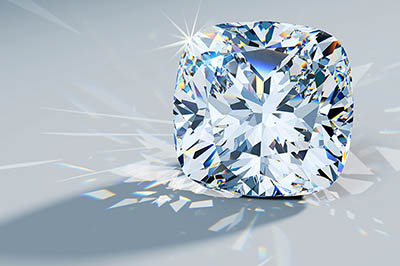Beyond the Four Cs: Other Factors to Consider When Buying a Diamond
Last updated December 2021
When shopping for diamonds, in addition to seeing how costs are affected by cut, carat, color, and clarity, consider these other factors:
Enhancements
Gem specialists can artificially boost the clarity and color of a diamond—think using lasers to improve clarity, filling cracks with clear materials, or using radiation to change its color. Enhancements usually lower a stone’s price, especially if the treatment is a temporary improvement, so there’s an obvious financial incentive for diamond traders to pass off enhanced gems as natural ones. Unfortunately, as enhancement techniques improve, they’re becoming harder to detect.
But it’s still worth considering diamonds that have undergone disclosed permanent treatments. For example, if you want a fancy-color diamond, you can pay hundreds of thousands of dollars for a pink diamond weighing more than two carats, but less than $20,000 if you buy one that’s been altered via irradiation. Similarly, irradiation can turn a diamond with unwanted noticeable color into a colorless stone that costs half the price of a naturally colorless one.
 Fluorescence
Fluorescence
When exposed to ultraviolet light, some diamonds produce visible light, or fluorescence, which is usually blue. The reaction is similar to how your teeth or a white shirt can glow or look whiter under certain lighting. Fluorescence is noted on a diamond’s GIA report in terms of intensity: faint, medium, strong, or very strong. But fluorescence is difficult to detect under normal lighting conditions and doesn’t affect a diamond’s color grade.
Because fluorescence doesn’t act the same way in all diamonds, it’s a somewhat confusing factor. In diamonds with higher color grades (G and up), fluorescence may (but may not) make them appear milky or hazy. For these types of mined diamonds, you’ll save about 15 percent if you accept a gem with medium fluorescence. But in lower grades, fluorescence can make diamonds appear brighter and whiter, so you’ll pay more (about two percent) for stones with it.
Metal
Platinum is known for its strength and luster, but it is more expensive than gold. But gold when scratched can reveal a different color underneath, whereas platinum won’t.
All gold starts out yellow and is then modified to alter color. Yellow gold mixed with an alloy (e.g., nickel, silver, or rhodium) is then often plated with rhodium to become white gold. Yellow gold mixed with copper becomes rose gold. White gold may fade to yellow over time and require replating (some jewelers offer free replating for items they sell).
Keep in mind that the higher the gold content (karat), the softer the metal. For engagement rings and wedding bands, most jewelers recommend 14-karat gold for durability. Because prongs made of gold may weaken over time, and platinum prongs may bend, have your jewelry inspected every year or so to determine whether repairs are needed.
Setting and Design
A clever setting can enhance how big your diamond looks. Seemingly magical, bling-expanding tricks include the currently popular halo setting, in which a central diamond is ringed with smaller pave stones, or pairing the diamond with a narrow band. But unless you are purchasing a vintage ring or necklace, buy a stone first and a setting second. Diamonds sold already set are suspect and often mounted in ways to disguise flaws.
You’ll find zillions of setting options for engagement rings and other diamond jewelry. In general, brand-name settings (we’re looking at you, David Yurman and Tiffany) cost more than just-as-good (and maybe better) custom settings from independent jewelers.
Avoiding “Blood Diamonds”
Many diamonds are mined in areas with deplorable working conditions and violence. Avoid these “conflict diamonds” by looking for a stone with a Kimberley Process Certification Scheme (KPCS) certification. Its members—countries that mine and sell diamonds, gem-industry pros, and human rights organizations—pledge not to trade or sell “rough diamonds used by rebel movements or their allies to finance armed conflicts aimed at undermining legitimate governments.”
Unfortunately, certification has been difficult to enforce. Diamond smugglers still channel conflict stones into the market, and the KPCS has done little to prevent the continued sale of stones mined in inhumane and violent conditions.
If this issue is important to you, look for the KPCS designation or other even stricter standards. For example, Brilliant Earth offers what it calls “Beyond Conflict Free Diamonds” and guarantees that its products are purchased only from mines it can verify as environmentally responsible and having ethical working conditions. Also look at diamond origins: Most mines in Canada, Namibia, and Botswana have high labor and environmental standards. Or stick with lab-grown diamonds.


